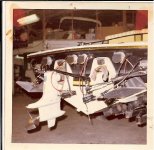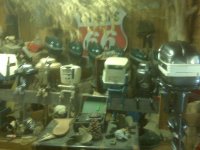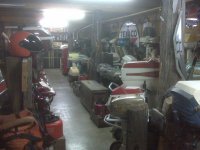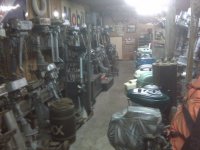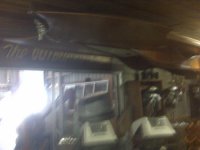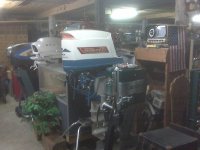Headlines
You are using an out of date browser. It may not display this or other websites correctly.
You should upgrade or use an alternative browser.
You should upgrade or use an alternative browser.
History of the speedmaster drive?
- Thread starter Dunbar 104
- Start date
Geronimo36
Charter Member
A mini #6 with a bravo as a transmission.
mbam
Sponsor / Charter Member
Not all speedmaster related, but what the heck.
The drive that rotated to put the gear case up in the air was the original #2 drive, turn a crank inside the boat and the whole thing spun around. I had thought the Old Man had a speedmaster lower to go on this drive, but I’m really not sure. The dog clutch shift was in the upper unit.
http://www.mercruiserparts.com/Show_pictures3.asp?dnbr= 37333&ivar=IMAGES/CRUISER/37333/C4.png&inbr=1560&bnbr=7&bdesc=GEAR+HOUSING+ASSEMBLY%2C+COMPLETE
The old OMC stringer drive had what we know as the transom assembly directly bolted to the engine, and yes there was a large rubber boot that sealed it to the boat. Power trim was an option and yes the entire engine moved on the mounts. There was a knuckle joint between the transom assembly & the drive, tilting the electric shift drive for shallow water or to trailer was accomplished by a worm/sector gear. They would come up almost 90 degrees if I remember correctly. You could run them in tilt position just above idle, any more than that was a disaster. It was fun to give your buddies a shower with it.
Volvo had the 270E drive, in fact they had a neat 6 cylinder engine to go with it. This was the standard Volvo upper with a really skinny dual drive shaft lower. Early 70’s if I have it right. I bet the torpedo was about 3” in diameter. Mercury did not have a counter rotate drive back then; at least for the small block stuff so many of the early Magnums & Cigs had the Volvos. These lowers were an instant 10 MPH or so over the stock Volvo. And ------------ they would break if you sneezed at them, never designed for a V8.
The #7 is kind of a transformers #6, same upper but a single drive shaft lower. Were not around for very long,
My Cig had the skegs cut off the #3 lowers when I bought it, would change direction any time it wanted
The drive that rotated to put the gear case up in the air was the original #2 drive, turn a crank inside the boat and the whole thing spun around. I had thought the Old Man had a speedmaster lower to go on this drive, but I’m really not sure. The dog clutch shift was in the upper unit.
http://www.mercruiserparts.com/Show_pictures3.asp?dnbr= 37333&ivar=IMAGES/CRUISER/37333/C4.png&inbr=1560&bnbr=7&bdesc=GEAR+HOUSING+ASSEMBLY%2C+COMPLETE
The old OMC stringer drive had what we know as the transom assembly directly bolted to the engine, and yes there was a large rubber boot that sealed it to the boat. Power trim was an option and yes the entire engine moved on the mounts. There was a knuckle joint between the transom assembly & the drive, tilting the electric shift drive for shallow water or to trailer was accomplished by a worm/sector gear. They would come up almost 90 degrees if I remember correctly. You could run them in tilt position just above idle, any more than that was a disaster. It was fun to give your buddies a shower with it.
Volvo had the 270E drive, in fact they had a neat 6 cylinder engine to go with it. This was the standard Volvo upper with a really skinny dual drive shaft lower. Early 70’s if I have it right. I bet the torpedo was about 3” in diameter. Mercury did not have a counter rotate drive back then; at least for the small block stuff so many of the early Magnums & Cigs had the Volvos. These lowers were an instant 10 MPH or so over the stock Volvo. And ------------ they would break if you sneezed at them, never designed for a V8.
The #7 is kind of a transformers #6, same upper but a single drive shaft lower. Were not around for very long,
My Cig had the skegs cut off the #3 lowers when I bought it, would change direction any time it wanted
Not all speedmaster related, but what the heck.
The drive that rotated to put the gear case up in the air was the original #2 drive, turn a crank inside the boat and the whole thing spun around. I had thought the Old Man had a speedmaster lower to go on this drive, but I’m really not sure. The dog clutch shift was in the upper unit.
http://www.mercruiserparts.com/Show_pictures3.asp?dnbr= 37333&ivar=IMAGES/CRUISER/37333/C4.png&inbr=1560&bnbr=7&bdesc=GEAR+HOUSING+ASSEMBLY%2C+COMPLETE
The old OMC stringer drive had what we know as the transom assembly directly bolted to the engine, and yes there was a large rubber boot that sealed it to the boat. Power trim was an option and yes the entire engine moved on the mounts. There was a knuckle joint between the transom assembly & the drive, tilting the electric shift drive for shallow water or to trailer was accomplished by a worm/sector gear. They would come up almost 90 degrees if I remember correctly. You could run them in tilt position just above idle, any more than that was a disaster. It was fun to give your buddies a shower with it.
Volvo had the 270E drive, in fact they had a neat 6 cylinder engine to go with it. This was the standard Volvo upper with a really skinny dual drive shaft lower. Early 70’s if I have it right. I bet the torpedo was about 3” in diameter. Mercury did not have a counter rotate drive back then; at least for the small block stuff so many of the early Magnums & Cigs had the Volvos. These lowers were an instant 10 MPH or so over the stock Volvo. And ------------ they would break if you sneezed at them, never designed for a V8.
The #7 is kind of a transformers #6, same upper but a single drive shaft lower. Were not around for very long,
My Cig had the skegs cut off the #3 lowers when I bought it, would change direction any time it wanted
That #2 drive was the hardest thing I ever saw to get off!
T2x
Icon/Charter Member
How does the NXT fit into all of this?
On the transom.
Steve Miklos
Charter Member / Competitor
Steve Miklos
Charter Member / Competitor
Steve Miklos
Charter Member / Competitor
It's good to be the boss
and have a private sanctuary
Somehow that just doesn't seem fair to the rest of us.......
and have a private sanctuary
T2x
Icon/Charter Member
and have a private sanctuary
Is that collection yours?
Steve Miklos
Charter Member / Competitor
Not exactly
I am not the current curator just the future one!
Steve
Is that collection yours?
I am not the current curator just the future one!
Steve
old377guy
Charter Member
OMC also had that two cycle drive where they laid a V4 outboard powerhead horizontally inside the boat and hung a sterndrive off the back. The whole thing passed through a big rubber bladder on the transom and when you trimmed it the entire assembly pivoted on the forward motor mounts. ( Later, after a few thousand leaks, I think they actually trimmed the sterndrive alone and at one point I believe they also had an option that rotated the sterndrive so it stuck up behind the boat with the nosecone facing the back seat passengers).It had the electric shift lower unit from the outboards and the only ones I ever saw were installed in boats manufactured by OMC ("The Evinrude boat" a pretty sort of gull wing hull and the "Johnson Boat" aka "The OMC Boat" which was a sort of trimaran/hydro design ala Custom Craft, which was nowhere near as fast as you might imagine).
Rube Goldberg apparently lived in Waukegan for a while.
An Evinrude boat pulled up next to me at the dock last week, I was all over the boat. I got the impression that the owner didn't realize what he had.
Tank
Charter Member
Speaking of cut down SSM#3's...A buddy had a 98 38 Scarab with #3's that had the skegs cut off on it. They were purchased from Bob Teague who had them on the straight bottom yellow Fountain for a long time in the late 80's early 90's. Bob upgraded the boat to #6's.
Here's an interesting article in Powerboat magazine, written by Matt Trulio (who's a member here). Great article, however, as I recall there was a rebuttal letter written by Weisman where they explained Weisman really wasn't the creator of the #6. I can't find the letter, but it was printed in PBM.
o well-branded is the super-tough No. 6 dry-sump drive from Mercury Racing that people tend to forget it began its life as an innovative creation from Weismann Marine.
power_0309_a.jpgThat’s right—for those of you who are too young to know this stuff or too old to remember any of it—Mercury Racing purchased the technology from the innovative Costa Mesa, Calif., company. Mercury refined the drive and was able to produce it at a volume Weismann Marine never could, but the concept, design and prototypes were straight from the fertile minds of Pat and Chris Weismann, the brothers who own and run Weismann Marine.
The Weismann brothers come by their inventive brain matter honestly—their father, Peter Weismann, and legendary offshore racer John Connor developed the patented Kaama drive that helped propel racer Betty Cook to several offshore world championships in the 1970s and 1980s. So for the Weismanns, innovation is in the blood.
More recently, the brothers teamed up to build a unique engine-and-drive package in AVR (Advanced Vessel Research), a 39-foot Extreme formerly named Ettore. The boat was originally powered by a pair of Paul Pfaff big-blocks installed low in the boat and “in line,” meaning with their flywheels facing one another rather than staggered side-by-side. To get the power to the twin Weismann Surface Drives, they used a clever V-shape offset box.
Their goal was balancing—or canceling if you will—the effects of camshaft rotation on handling. The idea was that if the engines were installed facing one another, flywheel to flywheel, the rotation of one camshaft would counteract the rotation of the other camshaft. The boat would not pull to the right or the left as a result of engine torque, because that torque would be balanced.
“You get the automatic benefit of engine counter-rotation,” said Pat Weismann.
The project produced mixed results and the boat was eventually sold by owner Scot Conrad to Dave Kutscher. Kutscher liked the concept of facing engines, but like the Weismann brothers, he was interested in efficiency and saving weight. In essence, he gave Weismann Marine a clean sheet of paper to not just install the engines and set them up with Weismann Surface Drives, but build the engines themselves. So the Weismanns started with the LS7, 427-cubic-inch Corvette platform and marinized a pair of them. As in the original Ettore boat, the engines were installed flywheel to flywheel.
“Nobody had done a marinized LS7 that I had seen, and we were after the best horsepower-to-weight ratio,” Pat Weismann said. “We were playing with efficiencies. We wanted to see how fast the boat would run with a minimal amount of horsepower. We’ve been working on engine packages to go with our drives and gear boxes.”
To that end, the AVR stepped V-bottom was equipped with a pair of Weismann Offset FNR transmissions, Weismann six-speed semiautomatic transmissions and Weismann surface stern drives. With the twin 650-hp, 384-pound engines turning 7,500 rpm, the boat averaged 104 mph during the late-2008 kilo runs on the Salton Sea (see “Track Record,” February 2009, Page 50).
“For a long time everyone thought big horsepower was the way to go,” said Todd Petersen of Racepak Data Systems, who engineered the boat’s electronics. “We wanted to come out and show people that there’s a different way to do it. With lightweight engines, a lower center of gravity, big props spinning more slowly—efficient everything—you can do nine-tenths of what you could do with bigger power.”
For most high-performance offshore and automotive product shops, that sort of project would be more than enough for a year. But there was another Weismann product-equipped boat at the Salton Sea Speedweek, a 23-foot, six-person military vessel with a 315-hp Yanmar diesel engine. With a 44-mph top speed, it certainly wasn’t fast. But it was equipped with the latest product-in-development from Weismann, a twin-propeller counter-rotating surface drive.
power_0309_b.jpg
The last attempt at such a drive was the Mercury Racing Blackhawk, and it failed. Setup was a challenge—no one could seem to dial it in consistently—and reliability was marginal. Mercury ended up pulling the Blackhawk from the market. But the product caught the attention and imagination of the Weismann brothers who believed that, if made reliable, a counter-rotating surface drive could work—and work well.
“The goal was trying to make a counter-rotating drive that was surfacing, because I hadn’t seen one that could take any horsepower,” Pat Weismann said. “The Blackhawk lasted about a year and went away. But it was intriguing, because counter-rotating propellers made a boat go extremely straight and eliminated handling issues—the boat doesn’t want to swap ends.
“The way the drive is designed, our counter-rotating drive has a single input through a universal joint and two sets of gears, clockwise and counterclockwise. It can be run as a single or as a twin. You can flip the rotation of the lead propeller. Because it’s counter-rotating, it kind of cancels all the ideas on inward and outward propeller rotation.”
At press time, the prototype drive, tabbed the WDP (Weismann Duo Prop), had 17 hours and Weismann said his team was “doing everything to try to break it—we only run at wide-open throttle.” To help speed up the process, the drive has giant six-blade propellers, 41"-pitch in the lead and 44"-pitch following. Weismann said development should be complete in six months, and that his goal is for the drive to be rated for engines up to 1,500 hp producing up to 1,600 foot-pounds of torque.
“I hate to put a horsepower number on it, because there’s so much more to it than that such as the weight of the boat, the propellers and so on, and people will always just push it to that number,” he said. “But that’s our goal.
“The project has no budget,” he added. “There’s no end-customer for it right now. It’s just something we wanted to do. It’s not that challenging when you start with a clean sheet of paper.”
At least for a Weismann.
– Matt Trulio is a freelance writer for Powerboat.
Here's an interesting article in Powerboat magazine, written by Matt Trulio (who's a member here). Great article, however, as I recall there was a rebuttal letter written by Weisman where they explained Weisman really wasn't the creator of the #6. I can't find the letter, but it was printed in PBM.
o well-branded is the super-tough No. 6 dry-sump drive from Mercury Racing that people tend to forget it began its life as an innovative creation from Weismann Marine.
power_0309_a.jpgThat’s right—for those of you who are too young to know this stuff or too old to remember any of it—Mercury Racing purchased the technology from the innovative Costa Mesa, Calif., company. Mercury refined the drive and was able to produce it at a volume Weismann Marine never could, but the concept, design and prototypes were straight from the fertile minds of Pat and Chris Weismann, the brothers who own and run Weismann Marine.
The Weismann brothers come by their inventive brain matter honestly—their father, Peter Weismann, and legendary offshore racer John Connor developed the patented Kaama drive that helped propel racer Betty Cook to several offshore world championships in the 1970s and 1980s. So for the Weismanns, innovation is in the blood.
More recently, the brothers teamed up to build a unique engine-and-drive package in AVR (Advanced Vessel Research), a 39-foot Extreme formerly named Ettore. The boat was originally powered by a pair of Paul Pfaff big-blocks installed low in the boat and “in line,” meaning with their flywheels facing one another rather than staggered side-by-side. To get the power to the twin Weismann Surface Drives, they used a clever V-shape offset box.
Their goal was balancing—or canceling if you will—the effects of camshaft rotation on handling. The idea was that if the engines were installed facing one another, flywheel to flywheel, the rotation of one camshaft would counteract the rotation of the other camshaft. The boat would not pull to the right or the left as a result of engine torque, because that torque would be balanced.
“You get the automatic benefit of engine counter-rotation,” said Pat Weismann.
The project produced mixed results and the boat was eventually sold by owner Scot Conrad to Dave Kutscher. Kutscher liked the concept of facing engines, but like the Weismann brothers, he was interested in efficiency and saving weight. In essence, he gave Weismann Marine a clean sheet of paper to not just install the engines and set them up with Weismann Surface Drives, but build the engines themselves. So the Weismanns started with the LS7, 427-cubic-inch Corvette platform and marinized a pair of them. As in the original Ettore boat, the engines were installed flywheel to flywheel.
“Nobody had done a marinized LS7 that I had seen, and we were after the best horsepower-to-weight ratio,” Pat Weismann said. “We were playing with efficiencies. We wanted to see how fast the boat would run with a minimal amount of horsepower. We’ve been working on engine packages to go with our drives and gear boxes.”
To that end, the AVR stepped V-bottom was equipped with a pair of Weismann Offset FNR transmissions, Weismann six-speed semiautomatic transmissions and Weismann surface stern drives. With the twin 650-hp, 384-pound engines turning 7,500 rpm, the boat averaged 104 mph during the late-2008 kilo runs on the Salton Sea (see “Track Record,” February 2009, Page 50).
“For a long time everyone thought big horsepower was the way to go,” said Todd Petersen of Racepak Data Systems, who engineered the boat’s electronics. “We wanted to come out and show people that there’s a different way to do it. With lightweight engines, a lower center of gravity, big props spinning more slowly—efficient everything—you can do nine-tenths of what you could do with bigger power.”
For most high-performance offshore and automotive product shops, that sort of project would be more than enough for a year. But there was another Weismann product-equipped boat at the Salton Sea Speedweek, a 23-foot, six-person military vessel with a 315-hp Yanmar diesel engine. With a 44-mph top speed, it certainly wasn’t fast. But it was equipped with the latest product-in-development from Weismann, a twin-propeller counter-rotating surface drive.
power_0309_b.jpg
The last attempt at such a drive was the Mercury Racing Blackhawk, and it failed. Setup was a challenge—no one could seem to dial it in consistently—and reliability was marginal. Mercury ended up pulling the Blackhawk from the market. But the product caught the attention and imagination of the Weismann brothers who believed that, if made reliable, a counter-rotating surface drive could work—and work well.
“The goal was trying to make a counter-rotating drive that was surfacing, because I hadn’t seen one that could take any horsepower,” Pat Weismann said. “The Blackhawk lasted about a year and went away. But it was intriguing, because counter-rotating propellers made a boat go extremely straight and eliminated handling issues—the boat doesn’t want to swap ends.
“The way the drive is designed, our counter-rotating drive has a single input through a universal joint and two sets of gears, clockwise and counterclockwise. It can be run as a single or as a twin. You can flip the rotation of the lead propeller. Because it’s counter-rotating, it kind of cancels all the ideas on inward and outward propeller rotation.”
At press time, the prototype drive, tabbed the WDP (Weismann Duo Prop), had 17 hours and Weismann said his team was “doing everything to try to break it—we only run at wide-open throttle.” To help speed up the process, the drive has giant six-blade propellers, 41"-pitch in the lead and 44"-pitch following. Weismann said development should be complete in six months, and that his goal is for the drive to be rated for engines up to 1,500 hp producing up to 1,600 foot-pounds of torque.
“I hate to put a horsepower number on it, because there’s so much more to it than that such as the weight of the boat, the propellers and so on, and people will always just push it to that number,” he said. “But that’s our goal.
“The project has no budget,” he added. “There’s no end-customer for it right now. It’s just something we wanted to do. It’s not that challenging when you start with a clean sheet of paper.”
At least for a Weismann.
– Matt Trulio is a freelance writer for Powerboat.
MarylandMark
Charter Member
What is the Merc #7 drive? I've seen it listed on their site.
diesel
edit- sorry; didn't see this was on page 4 already and already answered
OneBadInjun
New member
Since we're going on what we've heard, and hopefully the truth will surface,
I thought the 1 and the 2 were both TRS's with a foot change only?
Incorrect. They were completely different generation drives. The TRS and TR drives were the same uppers. The TRS was intended for Sportboats/Offshores mostly. The TR drive had a deeper gearcase to allow for up to 19" diameter propellers for larger vessels, houseboats, etc. The #1 and Mercruiser 2 drives and their corresponding transom plates, were a different design and era altogether.
DAREDEVIL
Banned
I'm positive the Super SpeedMaster II, was only a different foot. Everything else was the TRS.
The Super SpeedMaster I, I do not know for sure though.
SSMII had same uper and gimbal then TRS...correct,,,,TR II had gimbal and upper from SSM 3 but longer lower.
I had a set that i sold for cheap. Did not realize it was the same gimbal then SSM untill the guy that bought it showed me .
Damn was i stupid.
Similar threads
- Replies
- 2
- Views
- 342
- Replies
- 1
- Views
- 380
- Replies
- 3
- Views
- 1K

